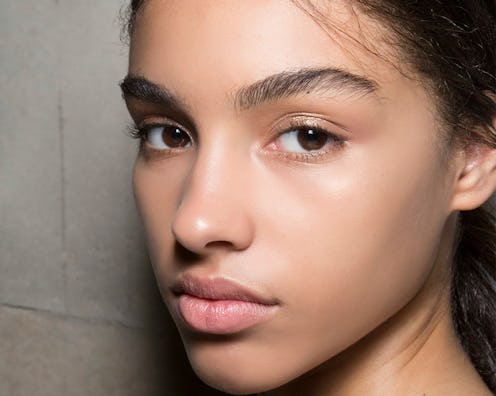All breakouts are frustrating no matter your age and, sadly, waking up to a monster zit doesn’t get any easier in your adult life. (There’s something particularly annoying about hormonal breakouts that pop up on your cheeks, chin and jawline.) At times, it probably seems like you’ve spent your whole life figuring out how to treat acne. And while diet, natural remedies and fancy formulas can be helpful in keeping your skin in the clear, even those efforts can be fruitless at times.
That’s when you know it’s time to consult with the pros. Skilled dermatologists all have their arsenal of solutions they keep up on hand for desperate cases. We tapped top derms and got their tips on how to treat the most stubborn acne. From super-effective topicals to in-case-of-emergency cortisone shots, these are the medical-grade solutions the pros swear by (and you should, too). Okay, let’s clear things up.
The Acne Lowdown
Topicals
Topical acne treatments are those applied directly to the skin. They can come in the form of a cream or gel and can be used in the morning or at night. This is the first step most dermatologists will take to treat acneic skin because they work on all types of blemishes, from whiteheads to cystic bumps. "The top prescribed topical acne fighters are retinoids, topical antibiotics, and retinoid-alternatives such as azelaic acid," says Dr. Sashu Hu of the Dr. Brandt Skin Advisory Board. "Some of the well-known brands of topical retinoids are Retin-A, Retin-A micro, and Atralin." Retinoids work to improve cell turnover and decrease the blockage of your pores. However they can cause peeling and redness, so patients are encouraged to keep application at twice a week and build up depending on the skin's tolerance.
Another effective yet gentle topical is Epiduo Forte by Galderma, which combines a prescription strength topical retinoid with benzoyl peroxide. "Adapalene is the most gentle retinoid, so you get improvement in acne, scars, texture and pigment, but it also has an antibacterial, benzoyl peroxide, so it really helps with those angry red pimples," notes New York City-based dermatologist, Dr. Dhaval Bhanusali.
If your acne isn't limited to your face but has spread to your chest and back, Joshua Zeichner, Director of Cosmetic & Clinical Research in Dermatology at Mount Sinai Hospital in New York City recommends Fabior Foam. "This medication is a topical retinoid in a unique mousse formula. It is easy to spread evenly over large surface areas and is particularly useful in treating acne on the chest on the back. It helps open blocked pores and enhance cell turnover, improving skin tone and texture while treating the breakouts."
Laser Treatments
Lasers or blue-light therapy treatments are typically recommended to speed up the healing of scars and pigmentation since they are known to resurface the skin and unclogged the pores. Dr. Jeremy Brauer prefers the Clear + Brilliant laser treatment "because it’s a well-tolerated laser resurfacing treatment for fine lines and pigmentation with minimal downtime, no peeling or prolong redness, and leaves the skin even-toned and cleared.”
Chemical Peels
Chemical peels are used to peel off the top layer of skin to reduce scarring, pigmentation, and fine lines to reveal a smooth complexion. A combination of low percentage acids provides the best exfoliation with minimal recovery time (aka you'll be able you to wear makeup the next day). For a deeper peel, select a higher percentage of a single acid like "salicylic acid because it absorbs directly into oil glands to reduce secretion, which ultimately leads to fewer breakouts," comments Dr. Bhanusali. For consistent acne, we recommend opting for a facial and peel combo, like Haven Spa Bootcamp Facial, which allows the skin to be extracted and then treated.
Antibiotics + Cortisone Shots
To combat severe acne, dermatologists will often recommend oral antibiotics in conjunction with topicals. Oral antibiotics are commonly used for their anti-inflammatory effects on those painful, big bumps.
Dr. Sashu explains the threshold for escalating acne therapy should be active scarring, regardless of acne type or patient skin type. For people with darker skin complexions, they may experience a higher degree of scarring and pigmentation problems from acne, so they will benefit from the extra boost of an oral antibiotic while waiting for their topical treatment to kick in. "However, antibiotics are not ideal for those with an active outdoor lifestyle as they cause sun sensitivity and, for those with digestive issues like acid reflux, they can worsen digestive stress."
Spironolactone is an anti-androgen agent that helps to decrease oil production. It's particularly beneficial to those with hormonal acne on the jawline and neck. However, it is a diuretic, so blood potassium levels need to be measured regularly.
Cortisone Shots
Usually, in the form of a cortisone injection and for emergency cysts only, this procedure must be performed by an experienced derm. They take a diluted steroid solution of cortisone, "a compound that has general anti-inflammatory properties. It is then injected into red, angry pimples to calm the inflammation within a few hours to bring down the swelling and allow it to heal itself," shares Dr. Joshua.
